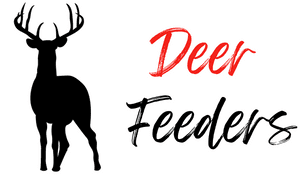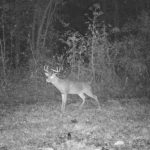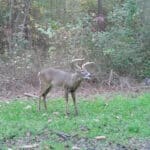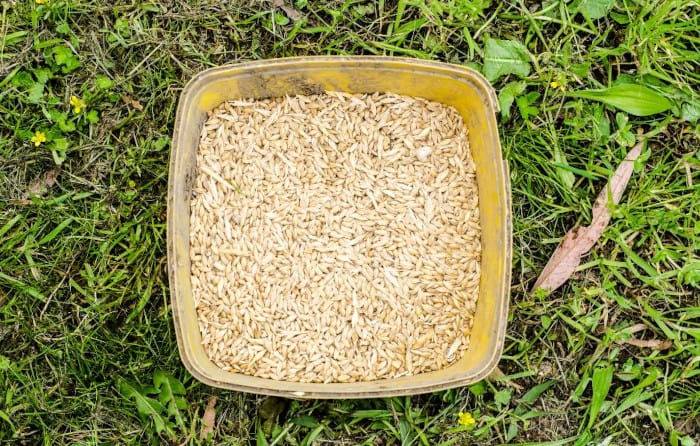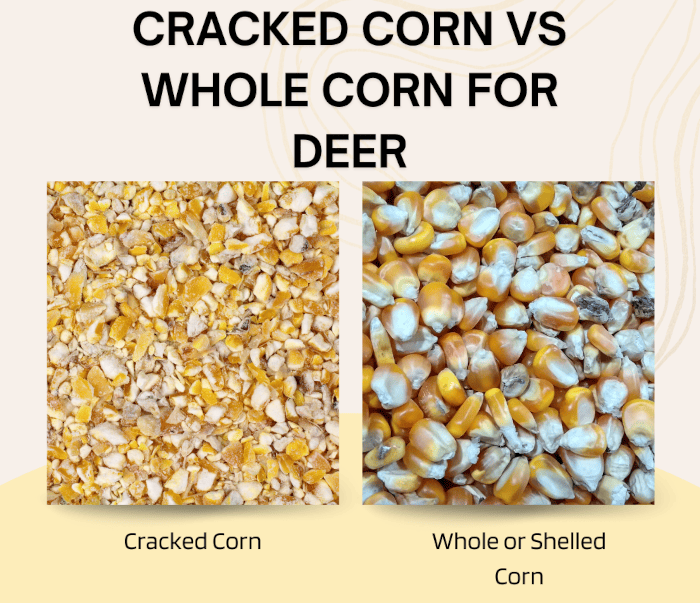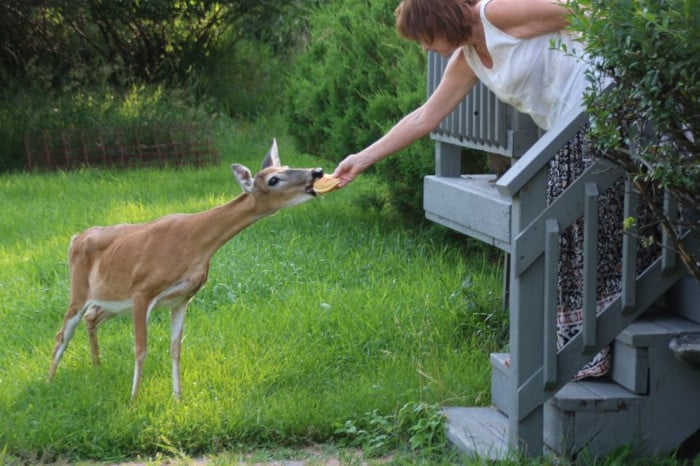Having a conversation today about deer attractants is very different from the attractant conversations I overheard as a kid. Back then, there weren’t any commercially made deer attractors on the market, so most hunters used naturally occurring foods like apples and pumpkins.
I had an Uncle who would go by the local grocery stores and buy all the apples that were over ripe. He would then place piles of those out of date apples at various locations around his deer stands to attract deer.
Now, times have changed as there are a plethora of commercially made deer attractors on the market. These days, the question seems to revolve around choosing the best deer attractant to mix with corn?
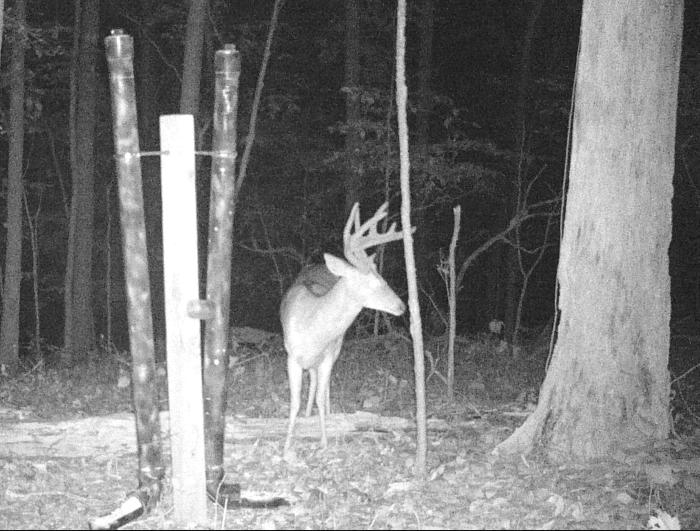
In this article, I will discuss the common questions associated with deer additives for corn and then look at my choices for the ten best corn additives and why they are my favorites.
A Word of Warning
Before starting any supplemental deer feeding or “baiting” (as it’s sometimes called), it’s vital to check your local or state regulations before to ensure that these types of activities are legal in your area. Also, I’d suggest checking those same regulations in your state about adding an attractant to corn or feed because some states have regulations against using any man made products for supplemental deer feeding.
Understanding How Deer Find Food
Before we get too far along in this post, it’s essential to understand some basic deer behavior. Whitetail deer are predominantly classified as herbivores, although there have been confirmed incidents where they will also feed on small mammals and fish if their preferred food sources are unavailable.
For the most part, whitetail deer are like most other animal species because they require a certain amount of daily food to maintain their health. How much food? Biologists estimate that the average whitetail consumes an estimated 2000 pounds of food annually. Because of their ongoing need to feed, deer researchers believe that whitetails spend about 70% of their waking hours searching for food or consuming a food source.
While deer are equipped with the same basic senses that humans have, a deer’s keen sense of smell is its most powerful sense. Deer use their noses more than any other sense, and their sense of smell is the primary method they use to locate food. Rather than go into depth about why deer have such a keen nose, I covered a great deal of information in this post about the strength and range of a deer’s olfactory senses.
Why use an Attractant with Corn
At my day job, one question I see being asked by new deer hunters is why use an attractant with corn if deer like to eat corn?
Here are a couple of reasons that a hunter might want to add an attractant to corn:
Stronger smell that may travel farther
Since deer primarily use their nose to detect food, most all food-based attractants are built to be aromatic. In most cases, the attractants have a more pungent smell than the corn, so the stronger smell may travel farther, attracting more deer.
Diversity of Smells
While deer like to eat corn, there are times when they seem to gravitate to other sources of food. For example, deer seem to really like apples and seem to prefer apples over raw corn.
One of the leases I manage has several deer feeders and some apple trees I planted several years ago. When those apple trees bear ripe apples, I see more deer at the apple trees than at the feeders. When the apples stop producing, the deer return to the feeder more frequently. I also see similar behavior when certain food plot crops mature as well.
This leads me to believe that, when available, deer prefer apples over corn. However, it also makes me think that the different odor offered by the attractant may be enough to bring in the deer that are only marginally interested in the corn.
Adding nutritional value to the deer diet
Some commercially made attractant options on the market also feature vitamins and minerals that are a critical nutritional piece for antler development and overall deer health. Typically, these materials are introduced to a whitetail’s diet through various natural food sources. However, there may be times when those food sources are unavailable or are insufficient to support a larger number of deer. Therefore, some hunters add these types of attractors to corn to attract deer and as a means to supplement these nutritional components in the deer’s diet.
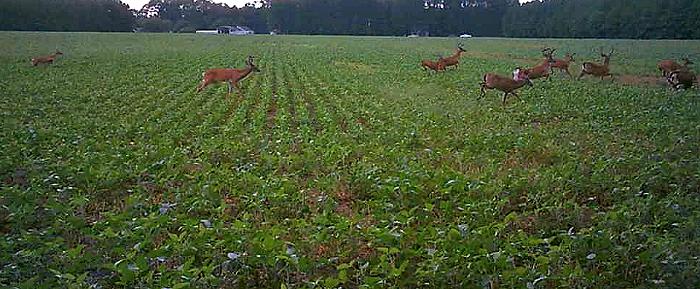
Types of Attractants
Typically speaking, there are three types of attractants commonly used with corn:
- Natural
- Homemade
- Commercial
Let’s go a little more in-depth on each attractant style:
Naturally Occurring Corn Additives
These are additives based on naturally occurring (for the most part) items and are typically sourced and added to the corn directly by the hunter. Some of these types of additives could be classified as homemade as well. Still, I prefer to differentiate the naturally occurring materials from the homemade options (which I’ll discuss in more detail below).
The most common examples of these types of attractants include:
- Apples (formats include juice, concentrate, and dried)
- Molasses
- Acorns (usually ground up to a powder or small pieces)
This style of attractant can be pretty effective as whitetails have a known affinity for these items.
However, these attractants are not foolproof and come with some pros and cons:
Pros
- Relatively easy to source
- Typically less expensive compared to commercially made deer additives.
Cons
- Depending on the specific additive, they may have some more labor-intensive preparation. For example, grinding acorns.
- Typically, they don’t last as long as commercially prepared attractants
- Typically, they are not as effective as commercially made deer additives.
I like to experiment, so, over the years, I’ve tried or tested several of the attractants that fall into this category.
I found ground acorns were effective but also the most labor-intensive to prepare. In addition, it takes a substantial amount of ground acorns to supplement 30 pounds of corn in a feeder.
Adding molasses was also relatively effective, but I didn’t see the same effect acorns produced.
I tried adding apple in various forms (including concentrate, juice, and dried chips) and found the results to be so-so. It appeared that the apple smell didn’t last near as long as the commercially made apple-based attractants. Therefore, I suspect the powered format is the optimum for corn.
Homemade Deer Attractants for Corn
If you’ve done any online research about the best deer corn additives, you’ve probably seen something about a homemade attractant for a DIYer. Typically, these homemade deer attractor recipes use:
- Vanilla
- Kool-Aid
- Peanut Butter
- Jell-O
- Etc.
This style of attractant comes with some pros and cons as well, including the following:
Pros
- Usually, the least expensive option for a deer attractant.
- Can be produced in bulk quantities.
- Allows control of the materials for experimentation.
Cons
- May involve materials or components that are not part of a whitetail’s natural diet, raising questions about potential adverse health and diet impacts.
- Depending on the components, it may only remain fresh and potentially effective for a short time.
- Typically, they are not as effective as commercially made deer additives.
There are probably hundreds of these different homemade recipes online, so I will do a separate article on these as I find them a very interesting option.
Commercial Produced Attractants for Corn
This style of attractant is probably the most common and the one that most deer hunters are familiar with. These deer attractants are commercially manufactured and sold by some of the biggest names in the deer hunting industry.
These products are available in many different formats, but powder seems to be the most common.
For this post, I’m going to focus on the commercially sold attractants for corn, and I’ll be going over my ten favorite ones, along with what I like and dislike about each.

10 Best Deer Attractants to Mix With Corn
If you do any research on deer attractants, you’re probably going to figure out that there are tons of deer attractant products on the market, with each one advertising its ability to draw in more and bigger deer.
I will try to cut through all the hype and talk about the ten best deer attractor products I’ve used to mix in with corn. In addition to discussing the product, I’ll also discuss the pros and cons and my experiences.
Here’s a quick overview of my ten favorites in an easy-to-read table format:
Attractant | Image | Format | Compatible with Gravity Feeder | Compatible with Broadcast Feeder | My Rating | Shop |
Wildgame Innovations Acorn Rage Deer Attractant | Attractant Only | Yes | No | |||
Lucky Buck Deer Attractant | Attractant & Mineral Supplement | Yes | No | |||
Big & J Deadly Dust | Attractant Only | Yes | Yes | |||
Antler King Apple Burst | Attractant & Nutritional Supplement | Yes | No | |||
C'Mere Deer Corn Coat | Attractant Only | Yes | No | |||
Antler King Roasted Bean Cuisine Deer Attractant | Attractant & Nutritional Supplement | Yes | No | |||
Orange Corn Company Deer Attractor | Attractant & Mineral Supplement | Yes | Yes - But Not Well | |||
Redmond Hunt Bomb Attractant | Attractant & Nutritional Supplement | Yes | No | |||
Wildgame Innovations Persimmon Crush | Attractant Only | Yes - But Not Well | No | |||
4S Advanced Wildlife Solutions Corn Spike | Attractant Only | Yes | Yes |
Wildgame Innovations Acorn Rage Deer Attractant
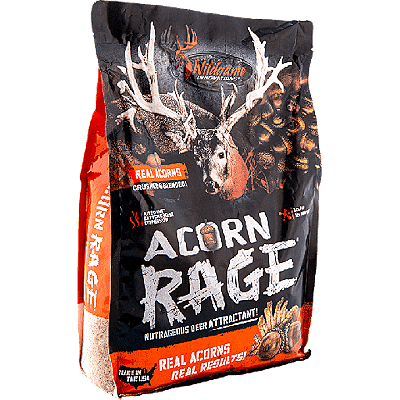
Wildgame Innovations offers several different deer attractant products, but not all of those products work well mixed in corn or on a corn pile. Their top-shelf deer attractant for corn is a product series called Acorn Range.
The Acorn Rage product is a blend of crushed acorns and roasted soybeans that is available in three different formats:
- Acorn Rage Brick or Block
- Acorn Rage Liquid
- Acorn Rage Powder
The powder formula is the best option for mixing corn, so I’ll focus on that specific format. Wildgame Innovations offers the powdered version of Acorn Range in two sizes: a 5-pound bag and a 15-pound bag.
Acorn Rage is more of a straight attractant as the formula doesn’t seem to include many additional minerals that help with antler development.
This product can be used on its own or mixed in with corn. When mixed with corn, Acorn Rage works best when deployed into a corn pile or when used with a gravity-based feeder. Technically, it can use with a broadcast feeder, but the broadcasting action throws the powder all over the place, making it less effective. I’ve found that it works best when mixed into a corn pile.
The 15-pound bag offers the best value, and I’d suggest using it in small amounts as it’s quite fragrant.
Here are some things that I do and don’t like about the Acorn Rage:
Pros
- It definitely seems to draw in more deer compared to raw deer corn.
- Very aromatic, so it’s easy to understand how deer could detect the smell from long distances.
- Easy to prep and easy to use.
Cons
- Doesn’t work well in broadcast-style deer feeders.
- I wish it had a higher mineral content as that helps with antler development.
- It’s not cheap and averages anywhere from $3 to $7 per pound.
- I would prefer that it was available in a larger-sized bag. The 15-pound bag is the largest size Wildgame Innovations offers, but a larger size would be more cost-effective.
In short, Acorn Rage works and works well. I hadn’t seen the bigger of the two bucks pictured below previously on a trail camera until I started using Acorn Rage. He showed up on camera the next day and has been back several times since. Unfortunately, he’s very cautious and only comes to the deer feeder after dark now. So this image is the only one I have of him during the day.
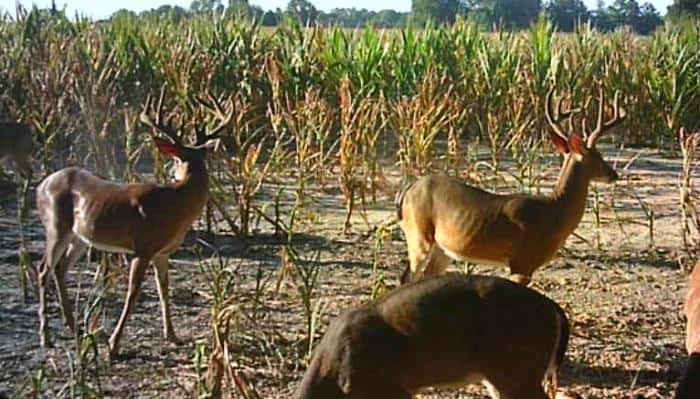
I’ve had excellent luck with it but be aware that it doesn’t last long when deployed without being mixed in corn.
Lucky Buck Deer Attractant
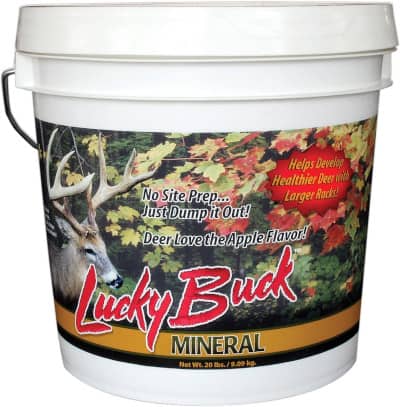
If you’re looking for a product that works as an attractant and offers a healthy dose of supplemental minerals for growing antlers, then Lucky Buck apple Flavored Mineral and Attractant is worth considering.
The Lucky Buck deer supplement is only available in a 20-pound container. Although Lucky Buck works just as well when used without corn, I think it works even better when mixed with corn. I pour a little Lucky Buck on the ground near the feeder, then mix about 2 pounds of Lucky Buck in with the feeder corn with a bit of water. The added water helps the powder attach to the kernels of corn.
The powdered format mixes and dispenses well in gravity-based and spinning deer feeders. For optimum effectiveness with broadcast feeders, I suggest slowing down the spin rate of the broadcaster so the powdered formula doesn’t come off the corn as its dispensed. If you cannot slow down the spin rate or spin strength on a broadcasting feeder, I’d suggest either sticking with a gravity-based deer feeder or deploying the Lucky Buck on the ground around the feeder. The first time I tested this stuff in a broadcasting feeder, I didn’t turn down the broadcasting strength, so it flung the corn so hard that the powder came off the kernels.
If you prefer not to mix it with corn, this supplement works equally well when dumped on the ground. I find it works exceptionally well when used over a pile of corn (without a feeder).
It has a strong apple scent that draws in deer, and the minerals help with antler growth and development. However, I’d also like to point out that it takes some time to start potentially seeing results with better antler growth. I say that to ensure realistic expectations with this product. I’ve had customers at my day job come back into the store complaining about the lack of noticeable antler growth after two months of adding Lucky Buck to their feeders. So while the attraction results are more immediate, the increased antler growth takes a few seasons.
Pros
- Has a strong apple smell, so deer can pick the scent from longer distances.
- Under the right circumstances, it can work in either gravity or spin-cast deer feeder.
- The included minerals will help with antler development and overall deer health.
- Is well priced and more cost-effective compared to other attractants on this list. Typically costs less than $1 per pound.
Cons
- The deer consume it fast, so it doesn’t last long (especially when just dumped in a pile on the ground)
- Although it can be used with a broadcasting deer feeder, the strength and volume of the broadcasting may overly distribute the powder, reducing its effectiveness.
Personally, I’ve had excellent luck with the Lucky Buck attractant and use it regularly. I’m a fan of this product based on its effectiveness and cost.
Big & J Deadly Dust
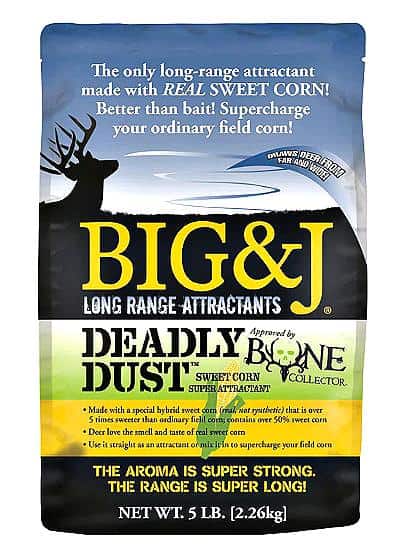
The Big & J Deadly Dust attractor is a powder-based formula derived from a special hybrid sweet corn that features 5x the sugar content of field corn.
Big & J Industries offer their Deadly Dust powder in two sizes: a 5-pound and 15-pound bag. From a cost perspective, this product ranges anywhere from $2 to 2.60 per pound in the five-pound bag and anywhere from $.78 to $1.50 per pound for the 15-pound bag. Therefore, the larger 15-pound bag is typically the more cost-effective option between the two sizes.
Since the Deadly Dust is really made to work exclusively with corn, it works well with the following uses:
- Mixed in with a corn pile or bait pile
- Mixed in with corn in a gravity feeder
- Mixed in with corn in a spreader feeder
In addition to being used in conjunction with corn, Deadly Dust can also be used as a standalone attractant. This formula has a strong aroma, and it is easy to understand how it attracts deer.
Pros
- Works extremely well. I usually see deer on camera in 24 hours (or less) when deployed in a pile on the ground.
- It gets consumed quickly, so it doesn’t last long.
- Is relatively cost-effective but not the most cost-effective option on this list.
Cons
- Does not work well when it gets wet. It seems to lose its effectiveness.
- It may draw bears as well, and they love it too.
Antler King Apple Burst

Antler King’s Apple Burst Attractant is an apple-based attractor product in a fine powder. As expected, it gives off a pleasant apple scent to bring deer in.
In addition to serving as an attractant for deer, the Apple Burst formula also features a protein and fat mix designed to maximize antler and body growth.
Apple Burst is only available in a fine powder format and only comes in a 5-pound bag. The average costs put this product costing anywhere from $2.50 to $3.50 per pound, so it’s not a cheap option.
The Apple Burst powder works best when mixed with corn in a corn pile or when used with a gravity-based deer feeder. It DOES NOT work well in a broadcast-style feeder as the powder is very fine and will quickly clog up the broadcaster. I had the best results when it was mixed in with field corn or deer corn in a corn pile or bait pile.
Pros
- It has a strong odor and does attract deer.
Cons
- It clumps when it gets wet and loses quite a bit of its aroma.
- Is a pricey option
- It also appears to attract bears (which may be an issue for the feeder)
C’mere Deer Corn Coat

I’ve been using the C’Mere Deer products for several years, and their Corn Coat formula is one of my favorites. Their Corn Coat product is a powder-based attractant that, as the name implies, is made explicitly for use with corn.
Another thing I like about Corn Coat is the fact that C’Mere Deer offers it in two sizes:
- A 24-ounce container that treats up to 300 pounds of corn
- An 80-ounce container that treats up to 1000 pounds of corn
On paper, the cost-effectiveness is a bit misleading as the product costs per pound come out to anywhere from $8 to $9 per pound. However, the 80-ounce container is enough to cover 1000 pounds of corn, so Corn Coat ends up being a very affordable option. In addition, depending on how much corn is used in a feeder annually, just one of the 80-ounce containers may last for a year or more.
This product seems to work best when mixed in a corn pile or when used with a gravity-based deer feeder. It can be used with a broadcaster-style feeder but tends to clog the feeder if not mixed into the corn well. Also, it clumps up if the product comes into contact with any moisture.
Something to be aware of: You might consider wearing a mask of some sort when mixing the C’Mere Deer Corn Coat into your corn. The product is a very fine powder that will create some dust if you mix it aggressively. Also, it doesn’t taste very good if you inhale it.
Pros
- A very cost-effective option that can last for a while.
- Has a strong candy-like scent that definitely attracts deer.
Cons
- It comes in a fine powder that clumps when exposed to any moisture.
- The odor seems to go away if the product gets wet.
- For maximum effectiveness, it needs to be mixed well into the corn.
Orange Corn Company Deer Attractor
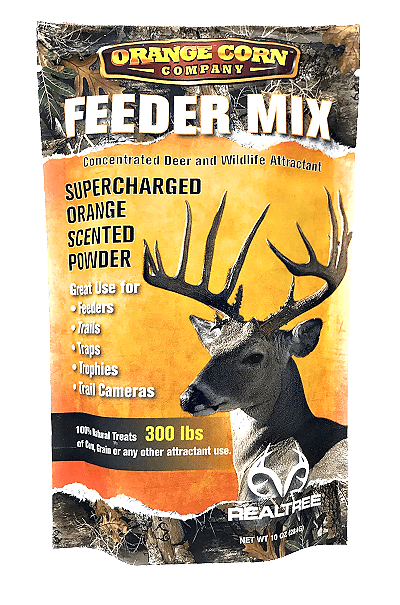
I have to admit that I had some reservations when I first saw this particular attractant, as I wasn’t sure how the deer would react to the orange flavor since it really isn’t a normal part of anything in their diet.
My experience with this product was so-so, and let me explain: There were some situations where the deer seemed to like the orange-flavored corn and others where they didn’t seem to care for it.
In instances where the deer liked the product, they aggressively responded to it with a noticeable increase in feeding activity. Conversely, it seemed to drive deer away from a feeder when they didn’t care for it. I advise testing a little bit of this product in a small corn pile near a feeder and monitoring the results before mixing some into a deer feeder.
The Orange Corn Company offers this product in three sizes:
- A 10-ounce bag that treats up to 300 pounds of corn
- A 5-pound bucket that treats up to 1800 pounds of corn
- A 5-gallon bucket that treats up to 16,000 pounds of corn.
Depending on volume purchase, this product costs anywhere from $0.25 to $0.36 per pound, so it’s a very cost-effective deer attractant. Obviously, the larger 5-gallon bucket offers the best bang for your buck but is also the most expensive option. However, depending on how much corn you use in a season, the 5-gallon bucket version may last for several deer seasons.
The Orange Corn Company Feeder Mix seems to work best when mixed in with corn on the ground or mixed into corn and dispersed through a gravity-based corn feeder. I did have some success using it with a broadcaster-style feeder, but there were some occasional clogging issues.
As I mentioned, if the deer like the taste, it’s a relatively cheap attractant option.
Pros
- Deer will either like the product or dislike it. Unfortunately, there doesn’t seem to be any in-between.
- Is a very cost-effective option.
- Has a strong orange scent that reminds me of orange candy.
Cons
- If the deer don’t care for it, they will start to stop visiting the feeder. I’d test first before deploying.
- Needs to be thoroughly mixed into the corn for maximum effectiveness.
- Seems to draw in an unusually high volume of squirrels and raccoons. More than usually seen with just deer corn.
- Also seems to attract bears, which can be a problem at a deer feeder.
Redmond Hunt Bomb Attractant (Apple or Cherry)
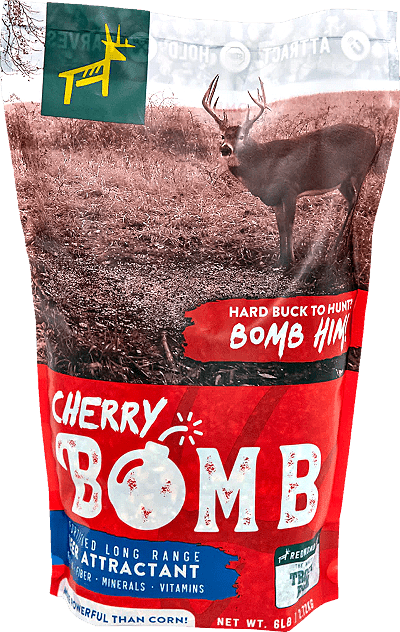
The Redmond Hunt brand is not quite as well known as some of the other attractant brands on this page, but they make some very good products. They are best known for their Trophy Rock Deer Mineral block. However, their Bomb Attractant products are pretty good performers as well.
Redmond Hunt offers the Bomb Attractant in two flavors:
- Cherry
- Apple
Both flavors are available in a powdered format or spray format. I’ll focus on the powder form, which is available in either a 6-pound bag or a 20-pound bag. From a cost standpoint, the Redmond Bomb Attractant costs anywhere from $.025 to $.037 per pound. The one thing I’m not crazy about with this product is the manufacturer’s suggested mix rate. Redmon Hunt recommends a 50/50 mix rate with corn, meaning that a 30-gallon deer feeder would require 125 pounds of attractant for the nearly 250 pounds of corn going into the feeder.
Personally, I back the mix rate down to 1 pound of attractant for every 20 pounds of corn. This product appears to work best when mixed into a pile of corn on the ground or when used in a gravity feed deer feeder. It does not work well in a spin cast deer feeder as it will clog the feeder up.
If you were planning to use the Bomb Attractor in a spin cast feeder, I’d consider going with the spray instead of the powder. I’d deploy the spray into some corn in a bucket, let it dry, then load it into a broadcasting deer feeder.
Another thing I like about this product is that it also provides some nutritional value in the form of minerals that are mixed into the powder format.
I’d suggest testing the two flavors side by side in test piles to gauge the deer’s preference.
Pros
- The powder format blends an attractant and minerals together for dual benefits.
- Available in apple or cherry scent and emit a strong aroma.
- Does seem to attract more deer than just bare corn alone.
Cons
- The manufacturer’s suggested 50/50 mix rate into corn seems excessively high, which drives the costs up quickly. Therefore, I’d suggest modifying the mix rate for your uses.
- It appears very cost-effective, but the higher mix ratio with corn significantly reduces cost-effectiveness.
- Not for use in a spin cast deer feeder, so a gravity-based feeder is the only feeder option.
Wildgame Innovations Persimmon Crush
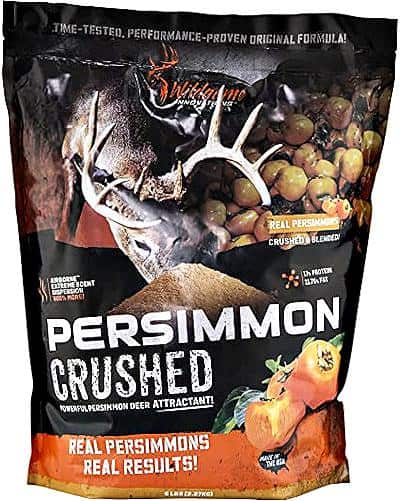
Wildgame Innovations offers several different deer attractant products in various configurations and flavors, including this Persimmon Crush attractant. Their Persimmon Crush attractor works well, BUT ONLY in areas with naturally occurring persimmon trees.
This product will likely perform well for you if you hunt in an area, state, or region with naturally occurring wild persimmon trees. However, the deer will most likely ignore it if you hunt somewhere that doesn’t have natural persimmon trees.
I put the Persimmon Crush attractant in the same boat as the Orange Corn attractor I discussed above; it works but only under specific circumstances. If you don’t have natural persimmons in your area, I suggest using another product.
The Persimmon Crush product is a powder-based attractant that is only available in a 5-pound bag. This product ranges from $1.90 to $2.25 per pound, making it a relatively expensive option.
Although the product can be mixed with corn in a gravity feeder, it performs best when mixed in with corn in a pile. I tested it in a broadcasting feeder, which bound up the broadcaster in less than a week.
However, if you hunt in an area with natural persimmon trees, it is a highly effective attractant that can draw in deer.
Pros
- Emits a strong odor
- Does seem to attract deer in areas that have natural persimmon trees.
Cons
- Works best in regions that have naturally occurring persimmon trees.
- Not an inexpensive option.
- Works best in a corn pile versus being deployed in a deer feeder.
4S Advanced Wildlife Solutions Corn Spike
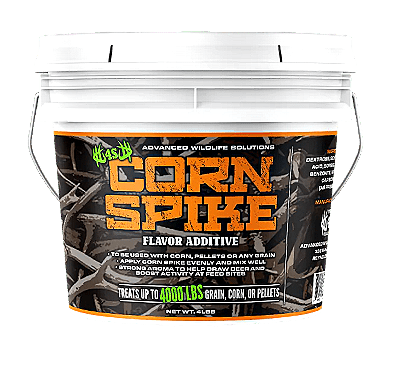
The Advanced 4S Wildlife Solutions brand isn’t as well-known as many of the attractant brands on the market. Typically speaking, if an attractant brand isn’t carried in a well-known sporting goods outdoor retailer, then most hunters probably haven’t been exposed to it.
That being said, the 4S Wildlife Solutions offers some very interesting products for whitetail hunters, including:
- Deer feed
- Deer attractants
- Deer Minerals
- Food Plot Seeds
I’m going to be focusing on their Corn Spike deer attractor, which is a powder-based product that is made specifically to mix with deer corn. Advanced 4S Wildlife Solutions offers the Corn Spike attractant in three different configurations:
- A small 1.6-ounce pocket can that treats up to 100 pounds of corn
- A 1-pound shaker can that treats up to 1000 pounds of corn
- A 4-pound bucket that treats up to 4000 pounds of corn
From a cost perspective, this product ranges anywhere from $10 to $14 per pound, which sounds expensive until you factor in the corn coverage rates. For example, the one-pound shaker costs around $14 and treats 1000 pounds of corn, which comes to a price of $0.014 cents per pound of corn coverage. The larger 4-pound bucket offers an even better corn coverage rate of $0.010 per pound of corn.
This product can be mixed into corn in a pile or a deer feeder. It seems to work well in both gravity-based feeders and spincast feeders. It has the granular consistency of salt, so it has run fine for me through spin cast feeders.
The Corn Spike formula has a powerful odor, so it’s easy to understand how it could attract more deer from farther distances. I’ve had good success with this product, and it’s relatively cost-effective.
Pros
- Works well for attracting deer.
- Works in both gravity feed and broadcasting deer feeders.
- When you look at the cost of corn treated per pound, it’s relatively inexpensive.
- Is available in different-sized containers for different uses.
Cons
- It also seems to attract more bears, compared to basic deer corn.
Antler King Roasted Bean Cuisine Deer Attractant
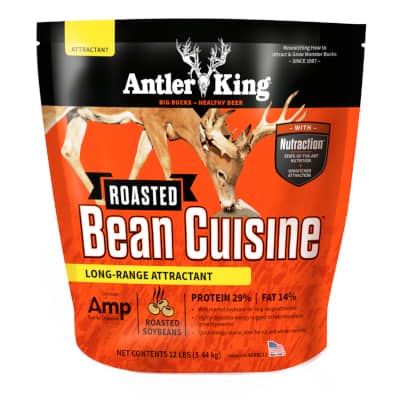
Much like the name implies, the primary ingredient in the Antler king Roasted Bean Cuisine attractor is roasted soybeans, with soybeans being a know deer favorite. The bean aroma is strong and should travel a long distance.
In addition to the bean component, this formula also contains Antler King’s patented supplement for easy digestion. Bean Cuisine is loaded with a significant amount of protein and fat to help deer grow and gain energy.
Roasted Bean Cuisine only comes in a small pellet formula that works well when poured directly on the ground or when used in gravity deer feeders. Unfortunately, it does not perform well in a broadcaster-style deer feeder.
Antler King offers this product in two sizes:
- A 5-pound bag
- A 12-pound bag
From a cost standpoint, the Bean Cuisine costs between $3.59 to 2.08 per pound, with the larger 12-pound bag being the more economical option. The cost per pound makes this a relatively expensive option, but I have found that deer like it.
Pros
- Comes in a pelletized formula that works well in gravity feeders.
- Has a strong smell that should travel long distances.
- Soybeans are a proven food source for whitetails.
Cons
- Very pricey per pound.
- Won’t work in a spin-casting deer feeder.
While I like the way this product performs, I’m not a fan of the price. The cost per pound makes this a relatively expensive option, but I have found that deer like it.
FAQS
Here are a few commonly asked questions that I see related to the best deer corn additive:
Can you discuss how to add flavor to deer corn?
Flavor can be added to deer corn through several different approaches, including:
- Buying pre-flavored deer corn
- Adding a commercial deer corn additive
- Mixing natural or homemade additives into the corn
Any of those options will introduce a new flavor or strengthen the existing flavor of deer corn. Out of those three approaches, the homemade option and the commercially made options for the most common.
The mixing process itself is fairly simply as most of the corn additives that were discussed above come in a liquid or powder form.
If the deer on my lease are already coming to my deer corn feeders, what’s the advantage to using one of these flavored corn attractors?
Honestly, if the deer on your lease are already eating corn at your deer feeders, it may not be all that beneficial to add an attractor to the corn.
However, corn attractants may bring in more deer than just raw deer corn, which can be beneficial to a deer hunter. Notice that I said “may” because corn attractants are not always 100% successful. In fact, in some cases, they can reduce the activity at a deer feeder. Because of this, I always recommend performing a small test first to see how the deer in your area react to a specific attractor.
Can these products make the deer go away?
Although most all of the corn attractor products that I discussed above are designed to attract deer, there may be the odd situation where it causes deer to avoid a feeder. I’ve seen this behavior before with some of the homemade corn attractants I’ve tested.
For that reason, I suggest doing some testing near a feeder before mixing a large amount of attractant into the feeder. I usually place some attractant directly on the ground near the feeder, and then see how the deer react to it. If they eat it off the ground, then it’s safe to use in the corn. If they avoid it, or stay clear of it, then I’d suggest trying a different product, or just sticking with raw deer corn.
Deer attractants are not a surefire way to entice that trophy buck into range. However, they can be a useful tool to attract more does, who, in turn, will eventually draw bucks during the rut. They can be a worthwhile product if the deer show an interest.
